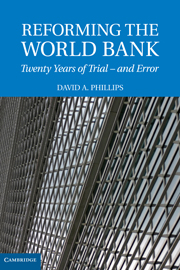Book contents
- Frontmatter
- Contents
- Preface: The Search for Effectiveness in the World's Premier Development Institution
- REFORMING THE WORLD BANK
- PART I ORIGINS AND EVOLUTION
- PART II THE SEARCH FOR EFFECTIVENESS
- 3 Fifty Years of Bank Reforms
- 4 The 1990s – Re-Engineering the Organization
- 5 Changing Culture and Changing People
- 6 Reforming the Bank's Assistance Product
- 7 Changing the Quality of Development Assistance
- 8 Financing the Reorganization
- 9 Why Did the Reforms Fail?
- PART III TOWARDS REAL REFORM: THE GOVERNANCE AGENDA
- Index
5 - Changing Culture and Changing People
Published online by Cambridge University Press: 25 January 2011
- Frontmatter
- Contents
- Preface: The Search for Effectiveness in the World's Premier Development Institution
- REFORMING THE WORLD BANK
- PART I ORIGINS AND EVOLUTION
- PART II THE SEARCH FOR EFFECTIVENESS
- 3 Fifty Years of Bank Reforms
- 4 The 1990s – Re-Engineering the Organization
- 5 Changing Culture and Changing People
- 6 Reforming the Bank's Assistance Product
- 7 Changing the Quality of Development Assistance
- 8 Financing the Reorganization
- 9 Why Did the Reforms Fail?
- PART III TOWARDS REAL REFORM: THE GOVERNANCE AGENDA
- Index
Summary
Closely parallel to the organizational re-engineering efforts was the attempt to restructure human resources. The restructuring exercise had two goals. First, it was intended to renew the organization's skills, and, second, it was intended to assist in changing the organization's culture.
The Strategic Compact spoke of a lack of systematic knowledge building and decline in knowledge generation, a lack of expertise, and an under-investment in training. The board of directors provided a restructuring fund that was supposed to allow redundancies to be phased in order to ‘allow the Bank to move away from large, one-time redundancy exercises, which had caused serious disruption in the past’, and to ‘adjust its staffing smoothly, equitably and cost effectively’. With regard to culture, it was supposed to change the attitudes and approach of the workforce, make them more participatory and less insular and elitist. How far were these twin aims of re-skilling and cultural change achieved?
‘CULTURAL CHANGE’
One of the keys to increasing the effectiveness of the Bank in the 1990s, like many other organizations both private and public, was supposedly to create a more effective culture. Members of the U.S. Congress and other outside observers thought this, and were loud in their belief in the need to change what they considered was the arrogant, insular, and elitist character of the Bank's staff, the ‘culture of pin-striped bureaucrats’, which, apart from offending the sensitivities of Congress, was regarded as dysfunctional for the Bank's work in reducing world poverty.
- Type
- Chapter
- Information
- Reforming the World BankTwenty Years of Trial - and Error, pp. 97 - 118Publisher: Cambridge University PressPrint publication year: 2009

